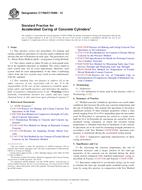Wir benötigen Ihre Einwilligung zur Verwendung der einzelnen Daten, damit Sie unter anderem Informationen zu Ihren Interessen einsehen können. Klicken Sie auf "OK", um Ihre Zustimmung zu erteilen.
ASTM C1768/C1768M-12
Standard Practice for Accelerated Curing of Concrete Cylinders
Automatische name übersetzung:
Standard Praxis für beschleunigte Aushärtung der Betonzylinder
NORM herausgegeben am 1.12.2012
Informationen über die Norm:
Bezeichnung normen: ASTM C1768/C1768M-12
Anmerkung: UNGÜLTIG
Ausgabedatum normen: 1.12.2012
SKU: NS-12388
Zahl der Seiten: 6
Gewicht ca.: 18 g (0.04 Pfund)
Land: Amerikanische technische Norm
Kategorie: Technische Normen ASTM
Kategorie - ähnliche Normen:
Die Annotation des Normtextes ASTM C1768/C1768M-12 :
Keywords:
accelerated curing, compressive strength, concrete cylinders, early-age strength, potential strength, ICS Number Code 91.100.30 (Concrete and concrete products)
Ergänzende Informationen
| Significance and Use | ||||||||||||||||||||||||
|
5.1 By increasing the concrete temperature, the rate of hydration increases and a larger portion of the later-age properties of the concrete can be attained during the short curing period compared with standard temperature curing as described in Practice C31/C31M and Practice C192/C192M. 5.2 Specimens subjected to accelerated curing can be used to estimate the later-age strength under standard-curing conditions by using this practice in conjunction with Test Method C918/C918M. The temperature history of the test specimens is recorded and the maturity index at the time of testing is calculated. Based on the measured maturity index and the early-age strength test results, the later age strength (such as at 28 days) under standard curing can be estimated from a previously established strength-maturity relationship for that concrete mixture. Thus accelerated curing procedures can provide, at the earliest practical time, an indication of the potential strength of the concrete sample. These early-age strength tests also provide information on the variability of the production process for use in quality control, so that necessary adjustments in mixture proportions can be made in a timely manner. 5.3 The user shall select the procedure to use on the basis of experience and local conditions. These procedures, in general, will be practical if a field laboratory is available to house the curing containers and the testing equipment to measure compressive strength within the specified time limits. |
||||||||||||||||||||||||
| 1. Scope | ||||||||||||||||||||||||
|
1.1 This practice covers two procedures for making and curing cylindrical specimens of concrete under conditions that increase the rate of hydration at early ages. The procedures are: A—Warm Water Method and B—Autogenous Curing Method. 1.2 The values stated in either SI units or inch-pound units are to be regarded separately as standard. The values stated in each system may not be exact equivalents; therefore, each system shall be used independently of the other. Combining values from the two systems may result in non-conformance with the standard. 1.3 This standard does not
purport to address all of the safety concerns, if any, associated
with its use. It is the responsibility of the user of this standard
to establish appropriate safety and health practices and determine
the applicability of regulatory limitations prior to use.
(
Standard Practice for Making and Curing
Concrete Test Specimens in the Laboratory Standard Test Method for Air Content of
Freshly Mixed Concrete by the Pressure Method Standard Practice for Making and Curing
Concrete Test Specimens in the Field Standard Test Method for Compressive
Strength of Cylindrical Concrete Specimens Standard Terminology Relating to Concrete
and Concrete Aggregates (Includes all amendments and changes
10/14/2021). Standard Specification for Molds for
Forming Concrete Test Cylinders Vertically Standard Test Method for Measuring
Early-Age Compressive Strength and Projecting Later-Age
Strength Standard Test Method for Temperature of
Freshly Mixed Hydraulic-Cement Concrete Standard Practice for Use of Unbonded
Caps in Determination of Compressive Strength of Hardened
Cylindrical Concrete Specimens Standard Test Method for Air Content of
Freshly Mixed Concrete by the Volumetric Method Standard Practice for Sampling Freshly
Mixed Concrete Standard Test Method for Slump of
Hydraulic-Cement Concrete |
Ähnliche Normen:
Historisch
1.12.2013
Historisch
1.12.2010
Historisch
15.12.2012
Historisch
1.7.2014
Historisch
1.4.2014
Historisch
1.10.2011



 ASTM C511-13
ASTM C511-13 ASTM C512/C512M-10..
ASTM C512/C512M-10.. ASTM C535-12
ASTM C535-12 ASTM C55-14
ASTM C55-14 ASTM C567/C567M-14..
ASTM C567/C567M-14.. ASTM C586-11
ASTM C586-11 Cookies
Cookies
